Excel Event Handling in C#
After I posted about getting up-and-running with managed code and Excel, I realised that I was really writing a brief introduction to coding a C# Excel addin. Then I realised that there are two more areas that need to be covered before we would be ready to start building a proper Excel addin in C# (and by proper I mean one that can be used by real Excel users to do real stuff). These are:
- Customising the ribbon;
- Trapping Excel events;
The ribbon is an Office-wide feature and has been covered in detail in other blogs and MSDN articles, so we won't cover it in detail here. A good article about the ribbon can be found here.
Instead, we'll focus on event handling in C# and how it compares to VBA.
Excel Event Overview
Excel events are COM events. They are defined in COM interfaces exported from Excel.exe. When we trap these events from VBA we're not really aware of the underlying mechanisms that enable Excel to callback into our code. The sinking and dispatching just happens automagically for us..
There are two broad parts of event handling: the event source; and the event handler. In the case of Excel, the event source is an instance of the Excel class that defines the event, such as a Workbook instance or a Worksheet instance. The event handler (or subscriber as some people call it) is the custom code (i.e., our code) that is invoked by the event source when the event happens.
The event source publishes a defined event signature which all event handlers must adhere to. As long as a handler adheres to this signature, the event source can invoke it when required.
Let's take an example: the Workbook.Open event.
When we use the VBA object browser to look at the definition of the Workbook class we can see that the event is called Open() and has a special lightning bolt symbol next to it indicating that it is an event.
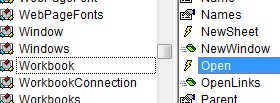
What the object browser did was look at the COM type library metadata for the Workbook class. As well as containing all the methods and properties of the Workbook class the type library also contains the published event signatures. The event signatures have special attributes applied to them. To see these, we use the OleView.exe tool to generate IDL from Excel.exe (note that this is a part of COM generally well hidden from Visual Basic. If you code COM components in C++ then this is should be very familiar to you).
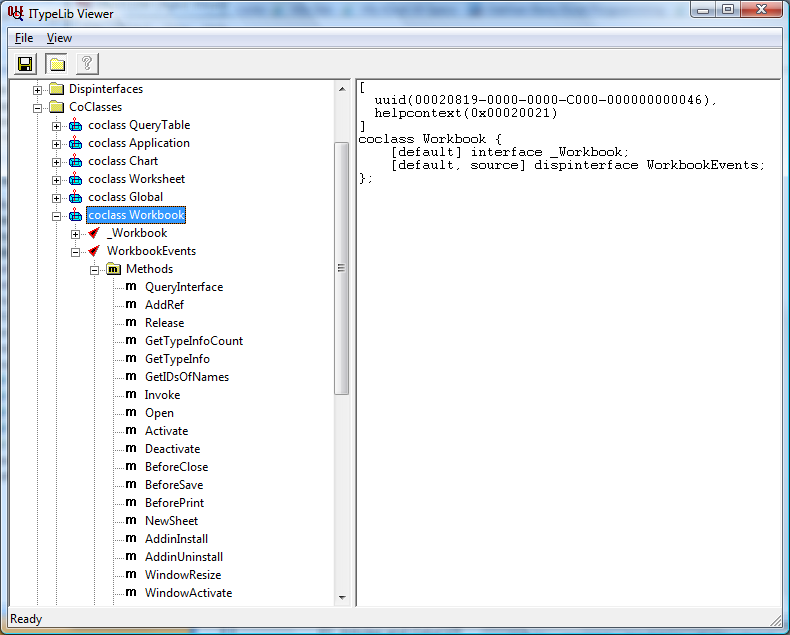
Notice that the Workbook class has two interfaces: _Workbook and WorkbookEvents. Notice also that the WorkbookEvents interface has an attribute named: source. This tells COM that the WorkbookEvents interface is an event source for the Workbook class.
COM has its way of handling events and .NET has its and, through the magic of COM interop, we can tie these two disparate programming models together. This means that we can have a COM event source and a .NET event handler.
However, the code we need to write to handle events in C# is very different from what we are used to writing in VBA. When we are coding in VBA, most of the event mechanism and underlying framework is hidden from us ... but not so in C#.
Delegates, Events and Excel
To C#, a COM event looks very much like a .NET event. This greatly simplifies things for .NET developers. However, if you are a VBA Excel developer moving to C#, the event mechanism in .NET seems complex and doing something simple, like handling the Workbook.Open event, can look like a mystery.
The first step to demystifying this is to understand what a delegate is.
A delegate is a special type of .NET class used in the .NET event mechanism. Think of them as being wrappers of function pointers. In COM an event is defined by its function signature whereas, in .NET, it is defined by a delegate but they both play the same role: they both define the contract between the event source and the event handler.
Let's take an example.
Let's say we are defining an event in our C# class called OnClick. We have to define the signature of the event. In C# this means defining a delegate and declaring the event to be of that (delegate) type.
Here's an example delegate and event definition:
public delegate void OnClickDelegate(string Title);
public event OnClickDelegate OnClick;
If we took out the delegate keyword, OnClickDelegate would look just like a function definition. Having the keyword delegate there wraps the function definition up into a type safe class. We then declare our OnClick event as being of type OnClickDelegate. This is us saying: we want an event called OnClick that has the signature defined by the OnClickDelegate thus, all event handlers have to have the same signature as OnClickDelegate.
At first, this seems overly complex ... but it's not really. It just takes a little getting used to (especially if you are from a VB background). If you ever coded in C/C++ and were used to passing around function pointers, this seems a wonderful step forward. Actually, it's one of my favourite parts of .NET :o)
So, what's this got to do with Excel programming?
Well, if you want to be able to handle Excel events in C# you have to understand delegates.
Handling Excel Events
So, let's take a look at what the C# code for handling Excel events looks like. For example, how do we handle the SheetSelectionChange event of the Application class?
_application.SheetSelectionChange += new Excel.AppEvents_SheetSelectionChangeEventHandler(_application_SheetSelectionChange);
void _application_SheetSelectionChange(object Sh, Excel.Range Target) {
//event handler code here
}
The first line creates a delegate of type Excel.AppEvents_SheetSelectionChangeEventHandler and adds to to the application object's SheetSelectionChange event. In the constructor of the delegate we pass the address of the function that the delegate encapsulates, in this case it is the _application_SheetSelectionChange function but it could be any function that has the same signature as the AppEvents_SheetSelectionChangeEventHandler delegate.
This is a subtle but important point, especially if you are used to coding VBA. In VBA we cannot specify the name of our event handler functions because the name indicates which event is being handled on which object. But in C# the event handler name is not important; what is important is the signature of the function. So, although our event handler is called _application_SheetSelectionChange which looks exactly like the name we'd use in VBA, we are free to change its name to anything we like as long as it still returns void and takes an object and Excel.Range as parameters.
So, to summarise: every time we want to handle an Excel event, we have to create an instance of the corresponding delegate and supply the address of a compatible function which the delegate encapsulates. This function is invoked by Excel when the event occurs.
But how do we know which delegate to create? In the example above, we created an instance of AppEvents_SheetSelectionChangeEventHandler but how did we know that and where do we go to find out the delegate types?
Excel's Delegate Names and COM Event Sources
When it comes to knowing which delegate type to use, Visual Studio comes to our rescue. Visual Studio detects that we are assigning a new delegate to an event and offers to auto-complete; generating both the delegate creation code and also an event handler function which complies to the delegate's signature.
So, consuming events is typically a case of typing <object name>.<event name> += <press tab twice to accept auto complete's delegate creation and function generation>.
But, its worth taking a deeper look at Excel's delegate names as it sheds some light on the underlying COM event interfaces.
If we look at the Application class's RCW (the ApplicationClass) in the Visual Studio Object Browser we see that it implements a number of interfaces.
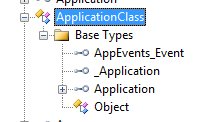
Notice that one of the interfaces is called AppEvents_Event. Remember that these interfaces are proxies/wrappers of COM interfaces, so, let's now look at the COM definition of the Application CoClass using OleView.exe.
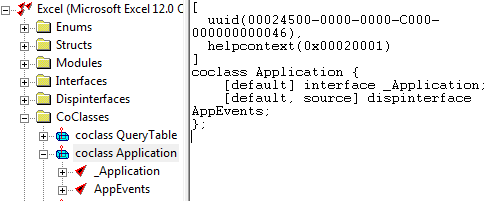
The Application CoClass implements the AppEvents interface. Also, the IDL tells us the the AppEvents COM interface is an event source interface for the Application CoClass. So, it turns out that the events for the Application class are actually all defined in one COM interface: the AppEvents interface. This is also something that is hidden from us when we are coding in VBA.
If we take a look at the definition of the COM AppEvents interface and the .NET AppEvents_Event interface we will see that they each define the Application events in their respective ways.
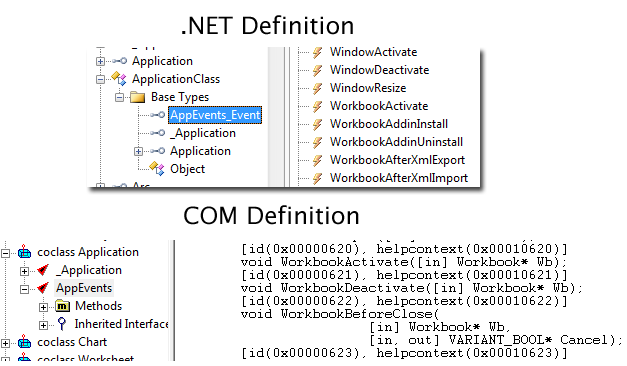
So, the AppEvents_Event interface in the PIA wraps up the AppEvents COM interface; the ApplicationClass in the PIA implements the AppEvent_Event interface and the Application CoClass in COM implements the AppEvents COM interface.
Given this we can now understand how the delegate names are generated, thus:
<COM Interface Name>_<EventName>EventHandler
i.e. AppEvents_SheetSelectionChangeEventHandler
Summary
Hopefully, this has laid out in clear terms out how we handle Excel events in C#. I have stayed away from talking about the specifics of how COM events actually work but this is a subject covered in detail on MSDN. What's more important to us, from an Excel point of view, is understanding the Excel event interfaces and how to use them from C#.
The key points to take away are:
- Excel events are COM events;
- Delegates are strongly typed wrappers of function pointers;
- .NET events use delegates to invoke event handling functions;
- The name of the event handling function is not important - it is the signature of the function that is important;
- Excel's COM classes have COM event interfaces and these map to the .NET RCWs in the Excel PIA;